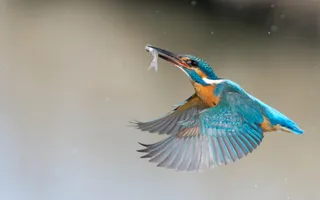The species you're most likely to see are the common pipistrelle, soprano pipistrelle, and noctule, as they emerge relatively early, around sunset.
We spoke to our trusted ecologists about the best bat-spotting places along our network.
The charity making life better by water
Making life better by water
Canals and rivers are dark corridors, free from surrounding light disruption, with water to drink and diverse insects to eat. While you can see bats on most of our waterways, here are the best places.
The species you're most likely to see are the common pipistrelle, soprano pipistrelle, and noctule, as they emerge relatively early, around sunset.
We spoke to our trusted ecologists about the best bat-spotting places along our network.
You might also spot plenty of bats along the Wolverhampton lock flight, on the Daw End Canal, and on the rural Rushall Canal.
Outside the hibernation period (November to March), you can see bats on most canals and rivers. Our reservoirs also make for excellent bat-spotting, often with high activity from soprano pipistrelles. This is particularly true during the maternal period. From June to August, the newly born young can double populations.
With the right equipment, you could find all 18 UK bat species along our canals and rivers. Common pipistrelles are typically found near our buildings. Noctules fly high and can pass over anywhere on our waterways near woodland and rough grassland, preying on large moths and flying bugs.
Wooded canals often have brown long-eared bats and natterers bats, but these two are late emerging bats, often up to an hour after sunset. Therefore, they're harder to see without thermal imagery or bat detectors.
To the west, the rare lesser horseshoe bats use our canal corridors, as well as the caves and large buildings along the way. This species is moving northwards with a recovering population following a catastrophic collapse during the period of DDT pesticide usage.
Another rare bat you might encounter is the Nathusius pipistrelle, a species capable of great migration from Eastern Europe across the UK – often navigating using our canals and reservoirs to fuel the journey.
The Daubenton's bat is our most associated bat as it is a true water specialist. However, they're late-emerging and avoid artificial light, so harder to see without bat detectors or specialist equipment.
With the loss and degradation of the UK's natural habitats, canalside buildings such as pillbox structures provide safe havens for many vulnerable species, including the nathusius pipistrelle bat.
Once serving as the last line of defence for Britain during World War II, these small structures may appear fairly unassuming. But, to the likes of nathusius pipistrellle bats, they're the perfect place to call home.
Our ecologists and volunteers have been transforming pillboxes, like this one at Saul Junction, into safe spaces for bats to eat, sleep and breed.
High levels of deforestation across the UK means bats now struggle to find suitable spaces to rest and roost. The pillbox provides plenty of dark, sheltered space and crevices, perfect for growing families.
After removing debris, litter and brambles, our teams fitted steel doors to the entrance and metal grilles to the small slot openings, to prevent bats from being disturbed.
Bat boxes were secured to the interior walls, and a rear hatch added to allow bats (and any bird species that might also benefit from these habitats) to safely come and go as they please.
But the pillbox isn't just a safe roof over their heads. This relic of the war also provides the cover bats need in a prime location.
Like all 18 species of bat in the UK, nathusius pipistrelles eat insects. With their preferred habitat location close to water and surrounded by plant life, the pillbox boasts an 'all you can eat' diner option right on their doorstep.
Meanwhile, our linear canal network provides a unique, natural passage for these small mammals to bypass the perils of our roads and travel safely in an increasingly fragmented countryside.
So far, our ecologists and volunteers have improved at least six pillboxes along our waterways and have plans to restore many more.
We need your support to keep canals and rivers alive. Donate today to make a difference
Last Edited: 28 April 2025

Sign up to our newsletter and discover how we protect canals and help nature thrive



